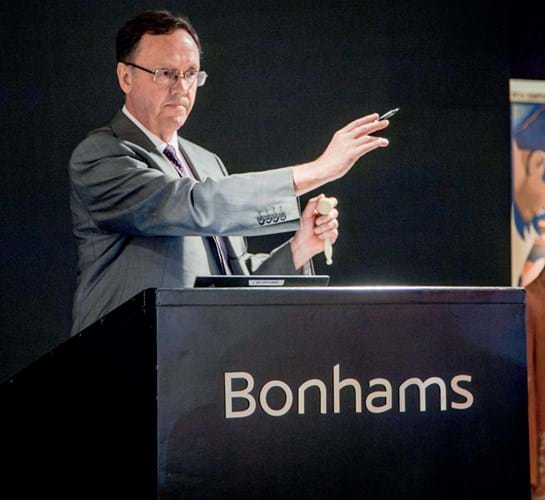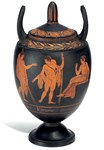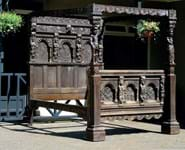
It’s the height of the London summer season and top-tier auctions are jostling with major fairs for buyers’ attention. As thermometers in the city hit 30-plus degrees centigrade, a Bonhams’ executive is keeping his cool amid a busy schedule of sales.
The venue is Bonhams Knightsbridge in Montpelier Street and ATG has been invited by its managing director and BBC Antiques Roadshow specialist, Jon Baddeley, to discuss the firm’s position in a fast-changing London auction scene.
Knightsbridge is the more youthful offshoot of Bonhams’ New Bond Street mothership, hosting its first sale in June 1956 under the stewardship of Leonard Bonham.
Today it is nothing if not eclectic – a reflection perhaps of Baddeley’s love for the quirkier elements of the market (see CV, above right). As he shows ATG around the lots amassed for a June 28 Entertainment Memorabilia sale – a Dalek from a recent Doctor Who series and a jacket once owned by Brian Jones stand out – his passion for the subject shines through.
Baddeley is keen to highlight Knightsbridge’s place in the evolving London scene, the firm’s focus on collectors and the importance for Bonhams of growing its own specialist talent.
Specialist focus
Baddeley baulks at the label ‘secondary saleroom’. Knightsbridge is described on Bonhams’ website as the firm’s second saleroom and that is more acceptable. “We have 70 people here, many of them specialists. This is a centre of excellence,” he says.
While Bond Street is “top-end international”, the distinction about where to sell is not always down to price, Baddeley explains.
“We put your object into the auction that will achieve the higher price. We don’t have value levels and we don’t get clients requesting where something should sell. There is always a discussion and it is down to what the client and the department agrees on.”
Meanwhile Baddeley is happy to sell some collections that larger rivals might not. “If someone has a single-owner collection valued at £200,000-300,000, then some of the bigger houses may think it’s not worth selling. But we do. For instance, we did the Attenborough sale [Richard Attenborough: A Life Both Sides of the Camera in October 2015]. It was a £750,000 sale which is small beans [to larger auction houses] but I am very enthusiastic about such sales.”
Cautiously online
When Christie’s South Kensington closes its doors for the final time later this month, Bonhams will be the only one of the ‘big three’ auction houses with two salerooms in the capital. Baddeley says he was surprised to hear of the closure, but says consignments to Knightsbridge and footfall have gone up as a result. “One assumes we will also see more attendance once they close.”
In a recent newspaper interview, Christie’s chief executive Guillaume Cerutti talked of the CSK closure, reasoning that “the digital space is the Christie’s South Ken of the 21st century”.
“Online is a wonderful tool for bringing in new clients. But then we encourage them to speak to us
With this in mind, is the ‘second saleroom’ not a leftover from a bygone era? Baddeley shakes his head emphatically. “We put on a show. It is dramatic, like theatre. People will travel nationally and internationally to come and view these items,” he says. “We need a bricks and mortar building to display them.”
He has witnessed first-hand the evolution of e-commerce. In “a previous life” Baddeley ran the sothebys.com website – and perhaps for this reason he believes in restraint when it comes to online sales because of fulfilment issues.
“In order to compete online, you need to be as good as Amazon,” he argues. “People expect to click, get a shipping quote, buy and have it delivered in 48 hours. Customer expectations are high. But the fulfilment side of it is not straightforward.”
Bonhams says that 40% of bidding across the group takes place online (with watches and prints among the categories currently sold online-only). “Online is a wonderful tool that brings in new clients, it opens a door. But then we encourage clients to speak to us, get a condition report and get our opinion. We want to form a relationship, then clients can gain that trust.”
Search for the new collector
Privately owned Bonhams rarely publicly releases its figures. However, a 2014 Financial Times article had Bonhams’ 2013 turnover at £127m with profits of £25m in what was a stellar year for the firm.
All Baddeley will say about Knightsbridge is that it is “one of the most profitable areas of the Bonhams network”.
The firm has made inroads by continuing to promote areas from which Christie’s and Sotheby’s have retrenched. More than 60 years since the first sale in Knightsbridge, the market has changed beyond recognition, but reinvigorating traditional collecting fields has been a Bonhams Knightsbridge focus for some time now.
Baddeley points to the success of the Antiques Roadshow as evidence of continued interest across the subject: the 4000 people who turn up at valuation days, week in, week out can’t all be wrong. “There is still a great thirst for knowledge.” he says.
A key growth market is collectors, both new and existing, though Baddeley says trade business is important too.
Bonhams focus on private buyers is perhaps one reason why the firm spent more than £1m on a refurbishment that changed the “Chesterfield and gentlemen’s club feel” of a former schoolhouse into a white-walled emporium of three galleries-come-salerooms, with air condititioning and sound-proofed valuation rooms.
Baddeley sees Bonhams Knightsbridge as an event space as much as the place where 25,000 lots are sold a year. It is extending its Sunday and evening viewing hours and laying on events for collecting societies and a younger crowd. “We need to encourage this entry level,” he says. “Otherwise where will we be in a few years’ time?
Next generation
Baddeley, who cut his teeth as a porter, is also keen to nurture the next generation of specialist valuers.
“Many who are running multi-million-pound departments here are in their 20s,” he says. “We promote from within. You need to drive the business with that younger talent. But it is also about balancing the experienced with the young.”
Will Bonhams Knightsbridge join the heady pursuit for CSK talent (see news, page 1)? “I have had conversations with people,” Baddeley says. “People know our door is open.”
In short, Bonhams believes the two saleroom model is the right one. “It is massively important that we are here,” Baddeley reiterates as ATG takes its leave. “With one of the players gone, that is sad and a shame for London. But we are committed to the long term.”
Curriculum Vitae
2010
Managing director of Bonhams Knightsbridge
2003
Joins Bonhams as global director of collectors’ sales
2002
Managing director at Windsor House Antiques
1990
London board director at Sotheby’s
1983
Rejoins Sotheby’s
1978
Becomes a dealer with GN&C Galleries and Jeremy Cooper
1973
Begins as a porter at Sotheby’s and works his way up to become head of the collectors’ department and an auctioneer by the age of 25
Bonhams Knightsbridge: some milestones
1956
Bonhams Knightsbridge’ first sale, following the opening of the saleroom by Leonard Bonham
2001
Bonhams & Brooks merged with Phillips Son & Neale. With Phillips’ former base at 101 New Bond Street now the HQ for the merged auction houses, Knightsbridge becomes the firm’s second saleroom
2015
Bonhams Knightsbridge begins a seven-figure refurbishment programme
Knightsbridge sells the Richard Attenborough collection
2016
Bonhams launch new range of monthly Home & Interiors auctions in its Knightsbridge and Edinburgh rooms
Sale of the Hugh Selbourne library (part one in 2015 and part two in 2016) makes a total of £2.6m















